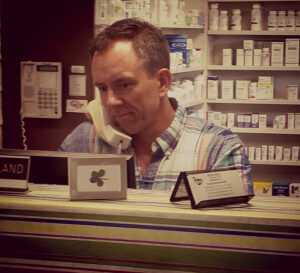By Deborah Jeanne Sergeant

Depending upon the drug, many people who take medication must wait three or four days to fill their prescriptions at their local pharmacy. Those who rely on mail order pharmacies may receive their medication mere days before they’re out of drugs instead of weeks in advance.
The American Society for Health-System Pharmacists recently stated that there are more than 300 medications experiencing a shortage, representing the highest level since 2014.
“It affects every day of our lives,” said pharmacist Sarah Driscoll, pharmacy operations supervisor at Oswego Health. “A lot are chemotherapy drugs, which we don’t use a lot at our hospital, but there are several of those that are difficult to acquire.”
She also noted that Adderall, often used to treat attention deficit hyperactivity disorder and narcolepsy, is hard to obtain. Although Oswego does not typically need Adderall for inpatients, it does need it and other scarce medications for outpatients using Oswego’s retail pharmacy.
Another example is Stadol, used for labor and delivery patients. If there aren’t alternatives for prescriptions that patients want, that becomes a difficult issue. Many want to stay on the medication they’re using, but if it’s not available, they may have to accept side effects they don’t want.
Another strategy is talking with different suppliers to find medication. However, prices vary among suppliers. This has caused increased spending for the hospital and pharmacy. Patients with insurance should still see the same copays.
Eventually, this strategy can lead to higher premiums as insurance companies recoup their costs.
The ASHP states on its website (www.ashp.org) that reasons for the shortage include product quality, deviations from good manufacturing processes and supply chain problems. Lack of raw materials and workforce issues may be only part of the reason that drugmakers aren’t supplying enough.
Pharmacist Craig Rowland at Pine Hill Hometown Pharmacy, Inc. in Cato, said the issue really ramped up in the past six to eight months.
“We’ve seen a dramatic increase of both over-the-counter and pharmaceutical shortages,” Rowland said. “Some are very critical medications with no other alternatives. We can’t even get a supply of normal saline for irrigation solution, which is an absolutely critical item, especially in a hospital setting.”
The severity and recent uptick of the shortages leads him to believe that offshore drug production is a major reason for the problem.
“There was a time not too long ago that 80% to 90% of our goods were supplied domestically,” Rowland said. “Quite the opposite holds true now: 80% to 90% of our goods are outsourced to other countries, primarily China and India. Things were good a few years ago when most of these products were manufactured and distributed right here in the US. We had very few issues related to any kind of shortage of anything. Since we’ve begun to rely on other countries to supply us, there’s a critical shortage. We have to bring back the production of these medications, especially the more critical prescriptions, back into the US.”
Until then, it can help if patients let their pharmacy know when they’re running low instead of expecting prescriptions to be filled the same day.
Rich Pinckney, pharmacist at Rx City Pharmacy in Auburn, said the pandemic has made it challenging for manufacturers to obtain raw ingredients.
“The other side is the FDA has shut manufacturing plants down because of procedures,” he said. “Thousands of units were recalled and are unavailable. They try to establish what they’ll need worldwide for the next five years. Then they shut down and transfer to making another pill. The other side is when you have a particular use of medication where you start to use it for a different purpose and something is discovered due to a side effect like weight loss for a diabetic medication, doctors start to use it for weight loss.
“What we guessed five years ago is no longer right because the medication is being used for another purpose.”
For example, if a medication becomes approved for an alternative use, the manufacturer may not have made a large enough supply during the five years in which they were making it. As a result, Pinckney’s staff receives about 30 to 40 phone calls daily requesting if different medications are stocked.
List of Drugs Affected
 American Society for Health-System Pharmacists states on its website that the drug classes in short supply include “local anesthetics and basic hospital drugs albuterol solution, common oral and ophthalmic products, and ADHD treatments are affecting large numbers of organizations and patients.
American Society for Health-System Pharmacists states on its website that the drug classes in short supply include “local anesthetics and basic hospital drugs albuterol solution, common oral and ophthalmic products, and ADHD treatments are affecting large numbers of organizations and patients.
Chemotherapy drugs, often without alternatives, are increasingly in short supply and have returned to the list of top-five drug classes affected by shortage.”
The ASHP lists on its website (www.ashp.org) the medications in short supply.




